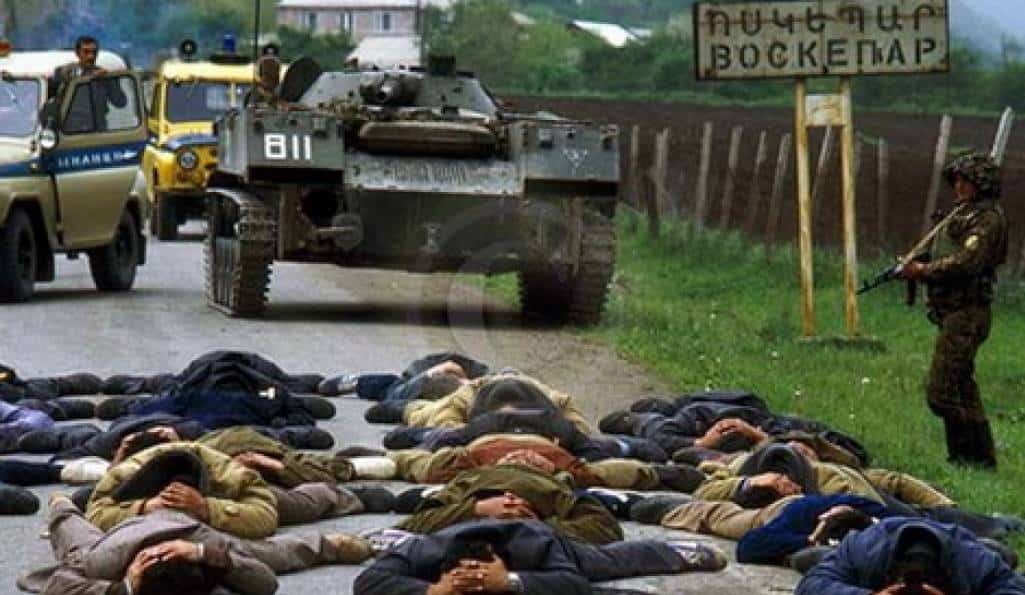

On the night of May 5-6, 1991, units of the 4th Army of Soviet troops, stationed in the territory of Soviet Azerbaijan, and Azerbaijani OMON, using helicopters, tanks, and heavy artillery, blocked the approaches to the village of Voskepar in the Noyemberyan district of Soviet Armenia and entered the village. The units of the Soviet army and Azerbaijani OMON that entered the village exploded one car, killing two and seriously injuring seven civilians.
Upon learning about what had happened in Voskepar, 20 police officers from the Noyemberyan district police department and three civilians attempted to penetrate the village through the forest to protect the residents. Eleven of them were brutally murdered, and the rest were seized and taken to the prison in the city of Kirovabad (Ganzdak, Ganja) of the Azerbaijan SSR, where another three people died. Units of Soviet troops also captured and handed over to the Azerbaijani OMON 45 Armenian policemen who were in the village and guarding the settlement, who were also subjected to torture in the Azerbaijani prison.
On May 8, as a result of shelling by the Soviet army, three more civilians from the village of Voskepar were killed.
The road leading to Voskepar today is different from its past. The awakening nature with blooming trees, lush greenery, and gentle breeze does not correspond to the atmosphere of that dark day when the crime was committed many years ago.
Thirty-three years ago, at dawn on May 6, 1991, 20 officers of the Noyemberyan police department and 3 of their companions fell into a trap set by the Soviet Army and Azerbaijani OMON (Special Purpose Militia Unit).
Karen Antonyan, the chief of the Bagratashen police department at the time, served in the special police unit of Vanadzor.
“On May 1, 1991, we received a report that Azerbaijanis had crossed the border of the Noyemberyan district and were advancing. The situation was dire. We took positions and began to defend the safety of the residents and our borders,” he says.
Shakho Melkonyan, the deputy chief of the Noyemberyan police department, describes the events in detail. He, one of those who remained in Azerbaijani captivity for 101 days, was a local police inspector at the time.
“It was the night of May 6. We were moving along a mountain road towards Voskepar. The village was 1-1.5 km away when suddenly soldiers emerged from hiding and stopped our cars. We didn’t realise who they were when suddenly they started shooting at us… Later, we discovered that they were soldiers of the Soviet Army stationed in Kirovabad, conducting the ‘Ring’ operation.
“The police officers heroically resisted, but the forces were unequal. Eleven Armenian policemen were killed. The rest were taken captive. Later, in captivity, the number of victims increased by another three.”
Georgi Kocharyan was a patrol officer at the time. He remained in captivity for 101 days.
“We were transferred to the police department in Gazakh (Kazakh) and from there to the prison in Kirovabad. We were all wounded in 2-3 places, but there was no medical assistance. The wounds of three of our guys were severe, and they died in prison…
“A few hours after the tragedy in the forests of Voskepar, Soviet soldiers also captured 45 Armenian police officers guarding the village and handed them over to Azerbaijani executioners from the OMON…
“The captives were subjected to unimaginable torture, but they did not give up, enduring it all with dignity and steadfastness.
“We encouraged each other and tightened our belts so no one would despair. We supported each other, even when we were beaten. Among us were guys who were more resilient and sturdy, and each time they volunteered to endure the beatings instead of others, to spare them, say those who went through the Azerbaijani prison hell…”
Karen Antonyan recalls the prison hell with a smile.
“I, Koryun Margaryan, and Garik Kotandzhyan were in the same cell. Koryun, as the commander, was often called out and beaten. The next day, when they came and asked, ‘Who is Koryun Margaryan?’ I answered, ‘I am.’ They got a good beating. After some time, they came again and asked who Koryun Margaryan was? And now Garik said, ‘It’s me.’ They took Garik away and beat him. After that, the guys from other cells did the same. It turned out that everyone in the cell was called either Koryun or Harut or… We behaved in such a way and endured the physical pain because we were beaten several times a day by 10-15 Azerbaijanis. We were left without water, without food, and in terrible conditions…”
They endured captivity with dignity and heroism, and after their release from captivity, they went back to defend the borders of their homeland.
Ararat Petrosyan is the Deputy Editor in Chief of Armenpress.
READ MORE: Aliyev’s representative proposes absurd demands against Armenia reminiscent of medieval expansionism.
A new archaeometric study of 66 marble artifacts from the early Byzantine villages of Porphyreon…
In a moving display of unity, the Greek Embassy in Israel held its National Day…
Athens, Greece, March 26, 2025 — Greek Prime Minister Kyriakos Mitsotakis swiftly welcomed Wednesday’s news…
Brisbane marked the 204th Greek Independence Day at Parliament House, hosted by George Mastrocostas. With…
Selinunte, Sicily—A team of archaeologists has excavated portions of the long-lost walls and north gate…
Trump’s 25% auto import tariffs aim to boost U.S. manufacturing but may spike prices by…